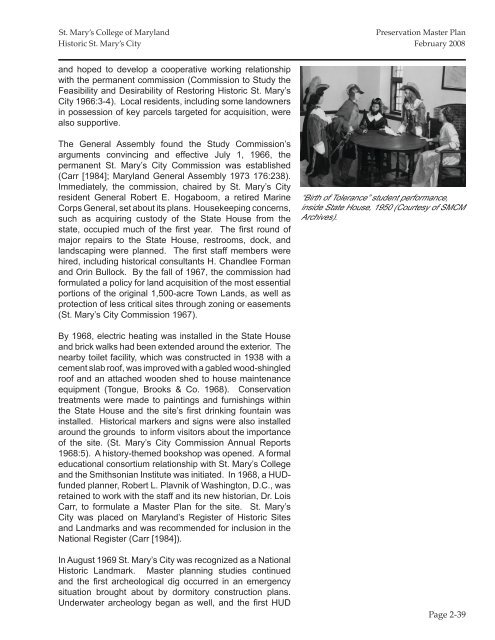St. Mary's College of Maryland Preservation Master Plan
St. Mary's College of Maryland Preservation Master Plan
St. Mary's College of Maryland Preservation Master Plan
- No tags were found...
Create successful ePaper yourself
Turn your PDF publications into a flip-book with our unique Google optimized e-Paper software.
<strong>St</strong>. Mary’s <strong>College</strong> <strong>of</strong> <strong>Maryland</strong><strong>Preservation</strong> <strong>Master</strong> <strong>Plan</strong>Historic <strong>St</strong>. Mary’s City February 2008and hoped to develop a cooperative working relationshipwith the permanent commission (Commission to <strong>St</strong>udy theFeasibility and Desirability <strong>of</strong> Restoring Historic <strong>St</strong>. Mary’sCity 1966:3-4). Local residents, including some landownersin possession <strong>of</strong> key parcels targeted for acquisition, werealso supportive.The General Assembly found the <strong>St</strong>udy Commission’sarguments convincing and effective July 1, 1966, thepermanent <strong>St</strong>. Mary’s City Commission was established(Carr [1984]; <strong>Maryland</strong> General Assembly 1973 176:238).Immediately, the commission, chaired by <strong>St</strong>. Mary’s Cityresident General Robert E. Hogaboom, a retired MarineCorps General, set about its plans. Housekeeping concerns,such as acquiring custody <strong>of</strong> the <strong>St</strong>ate House from thestate, occupied much <strong>of</strong> the first year. The first round <strong>of</strong>major repairs to the <strong>St</strong>ate House, restrooms, dock, andlandscaping were planned. The first staff members werehired, including historical consultants H. Chandlee Formanand Orin Bullock. By the fall <strong>of</strong> 1967, the commission hadformulated a policy for land acquisition <strong>of</strong> the most essentialportions <strong>of</strong> the original 1,500-acre Town Lands, as well asprotection <strong>of</strong> less critical sites through zoning or easements(<strong>St</strong>. Mary’s City Commission 1967).“Birth <strong>of</strong> Tolerance” student performance,inside <strong>St</strong>ate House, 1950 (Courtesy <strong>of</strong> SMCMArchives).By 1968, electric heating was installed in the <strong>St</strong>ate Houseand brick walks had been extended around the exterior. Thenearby toilet facility, which was constructed in 1938 with acement slab ro<strong>of</strong>, was improved with a gabled wood-shingledro<strong>of</strong> and an attached wooden shed to house maintenanceequipment (Tongue, Brooks & Co. 1968). Conservationtreatments were made to paintings and furnishings withinthe <strong>St</strong>ate House and the site’s first drinking fountain wasinstalled. Historical markers and signs were also installedaround the grounds to inform visitors about the importance<strong>of</strong> the site. (<strong>St</strong>. Mary’s City Commission Annual Reports1968:5). A history-themed bookshop was opened. A formaleducational consortium relationship with <strong>St</strong>. Mary’s <strong>College</strong>and the Smithsonian Institute was initiated. In 1968, a HUDfundedplanner, Robert L. Plavnik <strong>of</strong> Washington, D.C., wasretained to work with the staff and its new historian, Dr. LoisCarr, to formulate a <strong>Master</strong> <strong>Plan</strong> for the site. <strong>St</strong>. Mary’sCity was placed on <strong>Maryland</strong>’s Register <strong>of</strong> Historic Sitesand Landmarks and was recommended for inclusion in theNational Register (Carr [1984]).In August 1969 <strong>St</strong>. Mary’s City was recognized as a NationalHistoric Landmark. <strong>Master</strong> planning studies continuedand the first archeological dig occurred in an emergencysituation brought about by dormitory construction plans.Underwater archeology began as well, and the first HUDPage 2-39
















